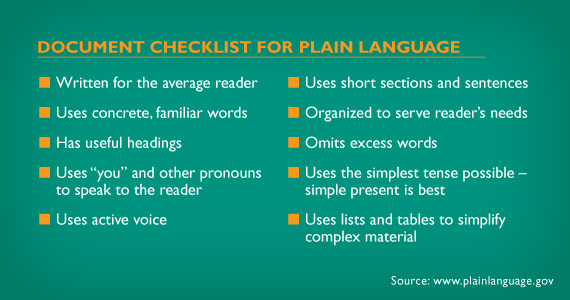The power of plain communication
“Excuse me but can you repeat that one more time in plain English?”
Writing healthcare communications is not an easy task. When communicating with the general public it is important to remember the gap between the medical professional and layperson in order to effectively get across your message. Because of the internet patients have access to healthcare information before seeing the doctor as well as after they visit. In order to write effective communication we must first understand the challenges involved. Based on these challenges, what are some ways in which we can improve our communications with our audience?

According to the CDC, Research indicates that most health information is not presented in a way that is usable by most adults. Here are some examples:
- Nearly 9 in 10 adults have difficulty using the everyday health information that is routinely available in health care facilities, retail outlets, media, and communities.
- Without clear information and an understanding of the information’s importance, people are more likely to skip necessary medical tests, end up in the emergency room more often, and have a harder time managing chronic diseases like diabetes or high blood pressure.
- About 1 in 3 adults has below basic or basic health literacy skills, which means they would find it difficult to read and follow instructions on a prescription medicine label.
This research reflects the state of the healthcare demographic and their comprehension rate when it comes to understanding health messages. Given these statistics it is crucial for a healthcare marketer’s writing to be as clear and effective as possible. Seeing repeat patients can turn into higher costs for a healthcare organization, especially in the ER. In 2010, President Obama passed into law the Plain Writing Act which requires federal agencies to use “clear Government communication that the public can understand and use.”
The term “plain writing” means writing that is clear, concise, well organized, and follows other best practices appropriate to the subject or field and intended audience.
This quote by George Orwell is a simple reminder of the basic questions every health care marketer should be asking themselves before they communicate with their audience.
“A scrupulous writer, in every sentence that he writes, will ask himself at least four questions, thus: 1. What am I trying to say? 2. What words will express it? 3. What image or idiom will make it clearer? 4. Is this image fresh enough to have an effect?” — George Orwell, “Politics and the English Language”, 1946
Modeling your communications after the Plain Writing Act and reading this quote can help to freshen up your perspective. Before embarking on your next piece of health care communication, whether it be a tweet, press release, or even your website think of the statistics and what you can do to beat the curve.
Pop quiz: Did I write this blog in plain English? Answer these questions in the comments below. How can your hospital or physician practice remain an authority on health and medical information to the community? What is necessary to effectively communicate your mission while also educating your patient community on their health and well being? Why would it be important to be an information resource to your patient community?
Plain Language: Tips for Starting
Plain Language: Federal Guidelines
A list of best dr. recommended websites
